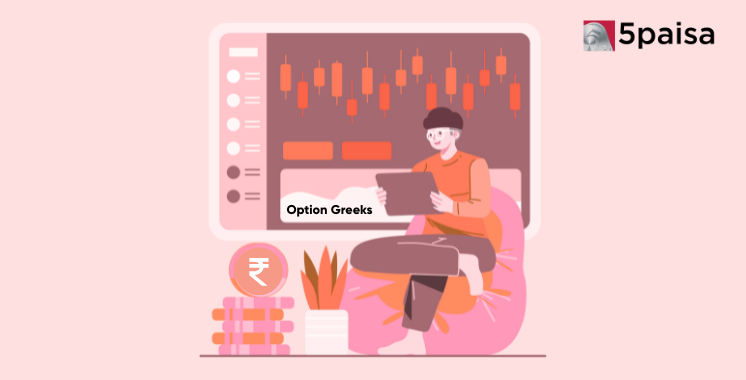Content
Option trading in India has evolved rapidly, especially with the rise of index-based weekly expiries like Nifty and Bank Nifty. While many traders focus solely on chart patterns or market news, very few dive into the Option Greeks, a set of powerful tools that can help you understand how an option is likely to behave under different market conditions.
This article breaks down what are Option Greeks, how each Greek works in simple terms, and how Indian traders can combine them to make smarter, risk-aware trading decisions—especially during intraday trading.
Unlock the full article - sign in with Gmail!
Expand Your Market Knowledge with 5paisa Articles
What Are Option Greeks?
Option Greeks are indicators that show how different factors like market movement, time decay, and volatility impact the price of an option. Think of them as tools to measure the internal health and sensitivity of an options contract.
Here’s a simple breakdown:
| Greek |
What It Is |
Meaning |
Tells You |
| Delta |
Measures how much the option moves with the stock |
Directional sensitivity |
How much the option premium moves when the underlying moves ₹1 |
| Gamma |
Measures how fast Delta itself changes |
Delta’s rate of change |
How quickly Delta shifts when the underlying price changes |
| Theta |
Measures time-related decay in premium |
Time decay |
How much value the option loses each day if everything else remains constant |
| Vega |
Measures impact of volatility on premium |
Volatility sensitivity |
How much the option premium changes when implied volatility rises or falls by 1% |
| Rho |
Measures sensitivity to interest rate changes |
Interest rate impact |
How the option premium reacts to a 1% change in interest rates (less relevant for short-term trades) |
How to Combine Option Greeks as a Trader
Understanding each Option Greek is only half the battle. What really sets skilled traders apart is how they combine these Greeks to make real-time decisions. Whether you’re buying options for a directional move or selling them to benefit from time decay, the right mix of Delta, Gamma, Theta, and Vega can shape your strategy.
Greek Profile for Option Buyers
| Greek |
Ideal Range |
Why It Matters for Buyers |
| Delta |
Medium to High (0.50–0.70) |
A higher Delta ensures the premium rises significantly with a favorable move in the underlying. This improves your chances of making money. |
| Gamma |
Moderate to High (only if experienced) |
A higher Gamma makes Delta change rapidly, which boosts profits in sharp moves. But it also increases risk, so it suits traders who can manage fast swings. |
| Theta |
Low |
As a buyer, time decay works against you. A low Theta helps preserve your premium if the trade takes longer to move in your favor. |
| Vega |
Prefer buying when IV is low |
If implied volatility rises after you enter the trade, the option premium increases. Buying when IV is low gives you more room for gains through Vega expansion. |
Buyers benefit from strong directional moves and rising volatility. The key is to avoid buying when Theta is high (e.g., nearing expiry) or when IV is already inflated.
Greek Profile for Option Sellers
| Greek |
Ideal Range |
Why It Matters for Buyers |
| Delta |
Low (0.20–0.40) |
A lower Delta means the sold option is less likely to move In-The-Money. This helps sellers collect premium without facing immediate risk from price movements. |
| Gamma |
Low |
A lower Gamma means the position won't change rapidly even if the market moves a bit. This makes it easier to manage the trade intraday. |
| Theta |
High |
Sellers earn from time decay. The higher the Theta, the faster the option loses value, especially as expiry nears. |
| Vega |
Prefer selling when IV is high |
High IV inflates option premiums. Selling in high IV allows you to collect more premium upfront and possibly buy it back cheaper once IV drops. |
Sellers thrive in range-bound markets or during expiry weeks. The ideal setup is high Theta decay, low Vega risk, and reduced directional exposure (low Delta).
Practical Intraday Trade Setups Using Greeks
Let’s go through two realistic intraday trading setups using Option Greeks in Indian markets. These examples show how different
Greeks work together in actual trading conditions.
Trade Setup 1: Directional Call Option Buy on Nifty
Market Condition: Nifty breaks above a key resistance level with strong momentum and volume.
Strategy: Buy an At-The-Money (ATM) Call Option with the following considerations:
- Delta around 0.55 for good directional exposure.
- Theta should be low (preferably early in the week when time decay is slower).
- Vega should be moderate or low to avoid overpaying due to high implied volatility.
Rationale: This setup is focused on capturing upward movement. Delta gives you responsiveness to the trend, and low Theta ensures your position doesn’t lose too much value if the move takes time.
Trade Setup 2: Volatility-Based Trade Ahead of a Major Event
Market Condition: A key event like the RBI monetary policy decision or earnings report is expected the next day.
Strategy: Buy an ATM Call or Put Option with:
- High Vega to gain from rising implied volatility before the event.
- Delta around 0.50 for balanced sensitivity to price movements.
- Acceptable Theta since the position is not held till expiry.
Rationale: When IV is expected to rise, options become more expensive. Buying early lets you profit from Vega expansion. It’s ideal to exit the trade before the event to avoid a sharp IV drop (Vega crush) if the outcome is already priced in.
Mistakes to Avoid When Using Greeks
- Looking at one Greek in isolation – Delta is popular, but ignoring Theta or Vega can be costly.
- Misusing Gamma near expiry – It can make or break your trade within minutes.
- Trading high IV options late – Premiums drop fast once volatility fades.
- Not adjusting for time – The same option behaves differently on Monday vs Thursday.
Wrapping Up: Use Greeks Like a Pro
To become a successful options trader in India, you need more than just a hunch or a chart pattern. Understanding and applying Option Greeks can give you a crucial edge—especially in fast-moving intraday trades.
Here’s how to start:
- Focus on Delta and Theta first.
- Use Gamma carefully near expiry.
- Watch Vega during high-volatility events.
- Use Greeks together, not in isolation.



